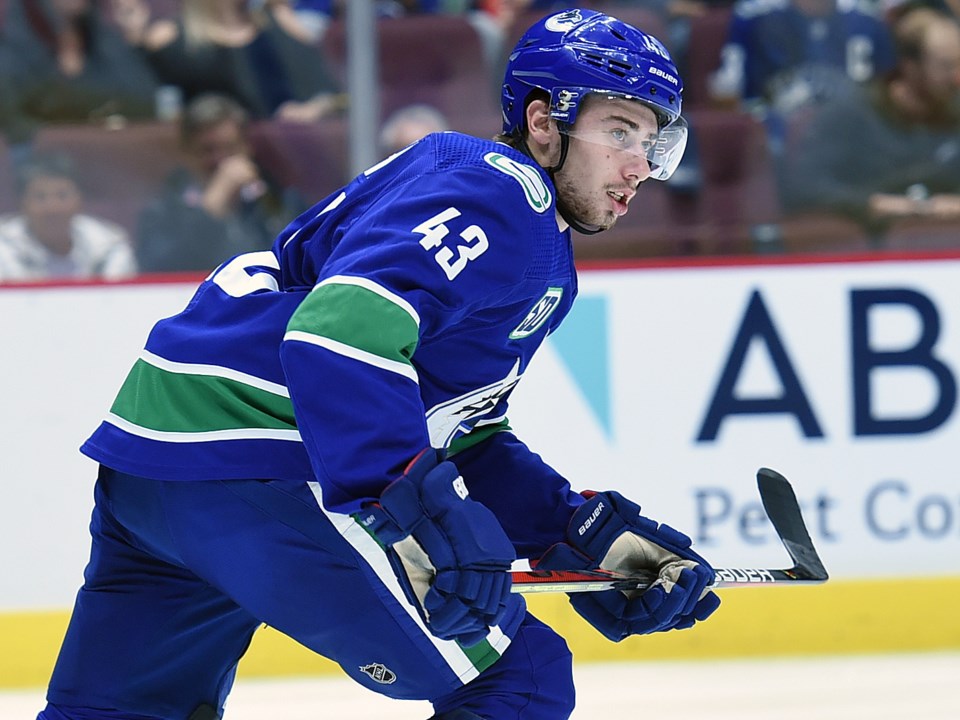The Paper Feature is a weekly column and sidebars that appears in the print edition of the Vancouver Courier newspaper. Track it down!
The Canucks’ power play has a tendency towards inconsistency, but when it works, it really works. That was aptly demonstrated last week, when the Canucks went 5-for-6 on the power play against the Nashville Predators, feasting on a penalty kill that seemingly had no answer for the Canucks’ top unit.
With a 26.7% success rate, the Canucks are fourth in the NHL in power play percentage. They look even better, however, since making a key change eight games into the season. Since moving rookie defenceman Quinn Hughes to the first power play unit, the Canucks have gone 23-for-75 on the power play. That leads the NHL in power play goals in that span and their 30.7% success rate is second only to the Tampa Bay Lightning.
There’s simply no denying the impact that Hughes has had on the Canucks’ power play, which becomes readily apparent when you look at the league leaders in power play points.
After Connor McDavid, who has been ludicrously good for the Edmonton Oilers, there is the Canucks’ Elias Pettersson, who is tied for third in power play points with McDavid's teammate in Edmonton, Leon Draisaitl, and David Pastrnak of the Boston Bruins. Close behind in fifth is Hughes, with 13 power play points in 25 games.
In case you missed it, that means Hughes leads all NHL defencemen in power play scoring. Not bad for a player that wasn't even on the first power play unit for the first seven games of the season.
Keep in mind, Hughes just turned 20 last month. The Canucks drafted Hughes just over a year ago. For him to be leading all NHL defencemen in power play points this early in his NHL career is nothing short of astonishing.
“As far as creativity, as far as being able to find the open guy, Hughes will be better than [Alex] Edler almost immediately on the power play,” said Ray Ferraro at the end of last season. “That’s what he does.”
Quarterbacking an NHL power play isn’t an easy task and Hughes has had his growing pains, but he’s quickly adapted.
“He’s come a long way in learning how to be a top guy on the power play and move the puck and when to shoot and when to pass,” said J.T. Miller to reporters after the Canucks beat the Capitals in a shootout on the weekend. “It’s way different than college — way less room and guys are way more responsible in their structure — and we told him it’s not going to be easy and he’s definitely doing a good job kind of hanging out in the middle of the ice and making good decisions.”
For Hughes, it’s not always about the spectacular play — though he’s made a few of those — but the little moments: the quick feet to chase down a puck and keep it in at the blue line; the smart pass to give a teammate more time and space with the puck; the lateral movement to open up passing and shooting lanes for himself and his teammates.
What’s most remarkable is that it seems like Hughes has yet to even fully hit his stride. The Canucks and Hughes have yet to fully figure out how to best use his elite skating ability on their power play breakout, which too often gets bogged down in the neutral zone. If they can sort out their breakout, they’ll be able to get set up more consistently in the offensive zone, leading to more opportunities to rack up goals.
In other words, there’s still work to be done and room to improve, something Hughes himself would readily admit.
“I'm feeling pretty confident, but at the same time, I'm not satisfied,” said Hughes.
With a total of 21 points in his first 25 games of the season, Hughes is on-pace for 68 points in his rookie year. That would be tied with Gary Suter for 3rd all-time for rookie defencemen, just behind Larry Murphy and Brian Leetch. It would also smash Doug Lidster’s Canucks franchise record of 63 points from a defenceman.
Is Hughes likely to reach those heights? It seems like far too much to ask and Hughes is likely to slow down as the tough NHL schedule wears him down, but it’s still a remarkable beginning to his NHL career.
Big Numbers
12 - Elias Pettersson is tough for opposing teams to contain legally, so they often have to do it illegally. Pettersson has drawn 16 penalties, second only to Brady Tkachuk, but Tkachuk has also taken six minor penalties and one major penalty; Pettersson has taken just four minor penalties, giving him a league-leading penalty differential of plus-12.
17 - At the other end of the spectrum is Alex Edler, who leads the league in minor penalties with 17. While he’s also drawn 8 minor penalties, his minus-9 penalty differential is still third worst in the NHL.
Stick-taps and Glove-drops
I’m dropping the gloves with Bill Peters, current head coach for the Calgary Flames, though that could change quickly. Akim Aliu, who was coached by Peters with the AHL’s Rockford IceHogs, went public this week with allegations that Peters used racial slurs to Aliu, claims that were corroborated by two of Aliu’s teammates.
A tap of the stick to Aliu and others that have come out this week and discussed publicly the abuses they’ve faced from their coaches. There is a toxic undercurrent in hockey culture that needs to be rooted out.



